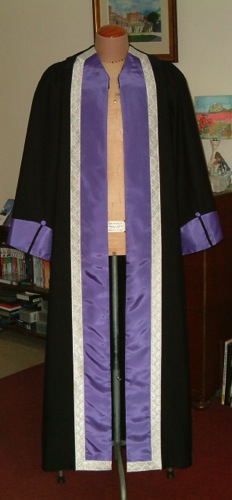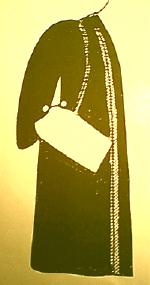During the academic year, the College has occasions when formal academic dress is appropriate. The following regulations are a guide to what is expected. The regulations are basically a compendium of current practice in the UK: they’re admittedly rather formal even though the College rarely stands on formality. Staff and students at St Chad’s are urged to use these regulations as a guide, but attendance at events is more important than being dressed ‘correctly’…
Regulations governing academic dress
Under Standing Orders (1998), the Governing Body of the College authorised the Principal to make regulations relating to academic dress in the College. The Principal has made the following regulations to replace the existing regulations.
1. Graduates of the College shall wear robes, gowns, and hoods of the colours, materials, and shapes as shall be from time to time prescribed by the University of Durham.
2. The Rector, Honorary Fellows and Foundation Fellows of the College shall wear, when appropriate, robes, gowns and hoods of the colours, materials, and shapes as shall be from time to time prescribed by the College under regulations approved by the Principal after consultation with College Fellows (see description below).
3. All students must acquire the appropriate gown upon arrival in College. Gowns are worn as announced: i.e., to College Congregations, Matriculation, Formal Hall, some chapel services, academic processions, and occasionally to events and services in the University, the Cathedral and elsewhere. Students of the College shall wear such gowns and dress as the Principal shall determine after consultation with College Fellows.
4. Students and staff of the College who are graduates of other universities may (if they so wish) wear the appropriate academic dress of their other university on any College occasion on which they would be required to wear academic dress (except when they are at Congregation to receive a Durham degree themselves).
5. Academic dress must be worn for:
(a) Matriculation (b) College Congregation (c) Installation of Associates, Fellows and Honorary Fellows (d) Installation of the Rector, Chair of the Governing Body, the Principal or other College Officer (e) Formal Visitation by the College Visitor (f) Any ceremony or occasion when there is an academic procession (g) As announced for formal photographs
6. At Matriculation and Congregation, and at the other occasions listed in n. 5 above, all students and graduate staff of the College are required to wear academic dress and may wear subfusc clothing, formal attire, or smart dress. Subfusc clothing is as follows:
Men. A dark suit and socks, black shoes, a white bow tie, and plain white shirt and collar. National dress may be substituted.
Women. A dark skirt or trousers, a white blouse, black tie, black stockings and shoes, and, if desired, a dark coat. National dress may be substituted Candidates serving in HM Forces are permitted to wear uniform together with a gown. (The uniform cap is worn in the street and carried when indoors.)
The above should be used as guidelines: the key is that the dress of men and women should be such as might be appropriate for formal occasions.
7. Students are required to wear gowns, if so instructed, when called for formal interview by the Principal or before a College Disciplinary Committee.
8. Students and staff of the College are required to wear gowns for Formal Hall unless otherwise announced. Guests are not required to wear gowns. Hoods and caps are not worn to Formal Hall.
9. Non-graduate guests invited to take a formal part in a College ceremony may wear a Scholar’s Gown.
10. Following the current practice in the University, undergraduates do not wear any academic headdress to University Matriculation or Congregation. Undergraduates do not wear bands except when graduating (when they are optional).
11. The general rules for head-wear are:
Wear when standing or walking (i.e., in procession, when speaking at a ceremony, or when going to receive an award), except when the Anthem is played.
Remove when seated, except in the case of the one who presides, who wears cap at all times except during the playing of the Anthem and during prayer.
12. The Principal, Vice-Principal and Senior Tutor may grant a dispensation from any of these regulations to any person who in their opinion has reasonable grounds for seeking such dispensation.
Description of the academic dress of the Rector, Governors, College Officers, Fellows and Honorary Fellows, staff and students of St Chad’s College
13. The Rector’s robe (below) is made in the Oxford doctors’ pattern in black corded silk with facings of palatinate purple taffeta edged on the outer edge with 1 1/2″ of silver oak-leaf braid. The sleeves are lined with palatinate purple silk which is brought out at the front of the sleeve and held in place with a black cord and palatinate purple button. There is a St Chad’s green cord and button on the black velvet yoke. This robe is generally worn with a black silk cassock and a palatinate purple cincture.
 14. The academic dress of graduate members of the Governing Body is the cap, gown and hood of their degrees from the granting university or a black mortar-board and gown (similar to the Durham scholar’s gown). Non-graduate members of the Governing Body may wear the scholar’s gown, but with no hood or cap.
14. The academic dress of graduate members of the Governing Body is the cap, gown and hood of their degrees from the granting university or a black mortar-board and gown (similar to the Durham scholar’s gown). Non-graduate members of the Governing Body may wear the scholar’s gown, but with no hood or cap.
15. The Principal, Fellows and graduate staff members of the College shall wear the cap, gown and hood appropriate to their highest degrees, except that all Fellows may wear the College hood when appropriate.
 16. Non-graduate academic-related members of College staff may wear a scholar’s gown, but with no hood or cap.
16. Non-graduate academic-related members of College staff may wear a scholar’s gown, but with no hood or cap.
17. Postgraduates generally wear the cap, gown, and hood of the university from which they received their highest degree, but they are free to wear the academic dress corresponding to any of their degrees or a black gown (similar to the Durham BA or MA gown), with or without their own hood and cap.
18. Fellows, Foundation Fellows and Honorary Fellows of the College (whether graduate or not) wear the gown and hood of their degrees from the granting university or a black mortar-board and black gown (similar to the Durham scholar’s gown). They may also wear the College hood, which is especially appropriate when inducting new Fellows (see n. 21 below).
19. Ordained members of College may always wear clerical garb, as appropriate. Bishops may wear convocation habit.
20. Associates of St Chad’s College and graduates of the College holding a Diploma in Theology are entitled to wear the College’s hood: either the older hood (Cambridge MA pattern, the cowl faced inside with 2″ olive-green silk) or the current pattern, Oxford simple-shape, faced inside with 2″ olive-green silk and lined with blue-green brocade.
21. Undergraduates wear the College undergraduate gown (see diagram on right), which is the same as the University of Durham undergraduate gown, except for the addition of a college green twisted cord (approx. 5 in long), held by two black buttons on each of the bottom vent edges of the sleeves. The Senior Man and the MCR President may wear a full-length scholar’s gown (University of Durham style) with facings of college green. Organ Scholars and Horsfall Scholars are also entitled to wear full-length scholar’s gowns.
22. College colours: Undergraduates may wear the college green undergraduate tie; graduates of the College and current postgraduate members of the College may wear the College’s blue graduate tie.

